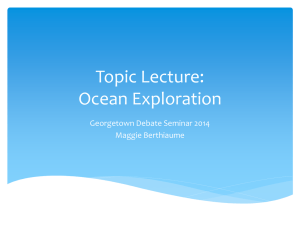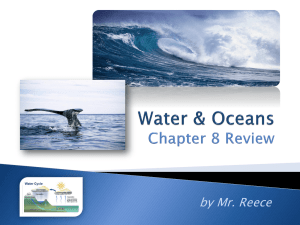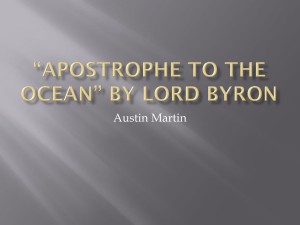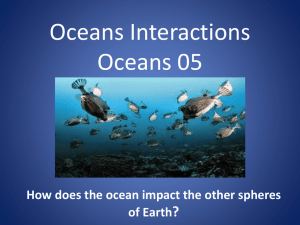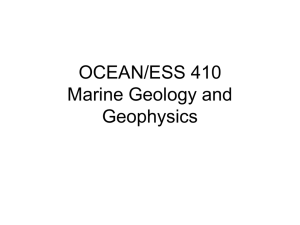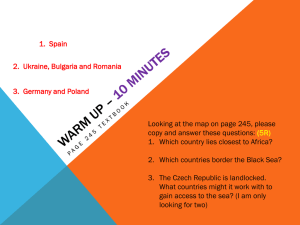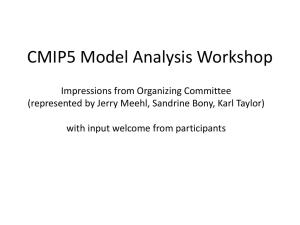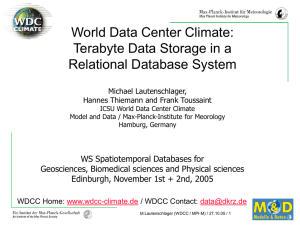Coupled & Ocean Modelling - Johann Jungclaus
advertisement
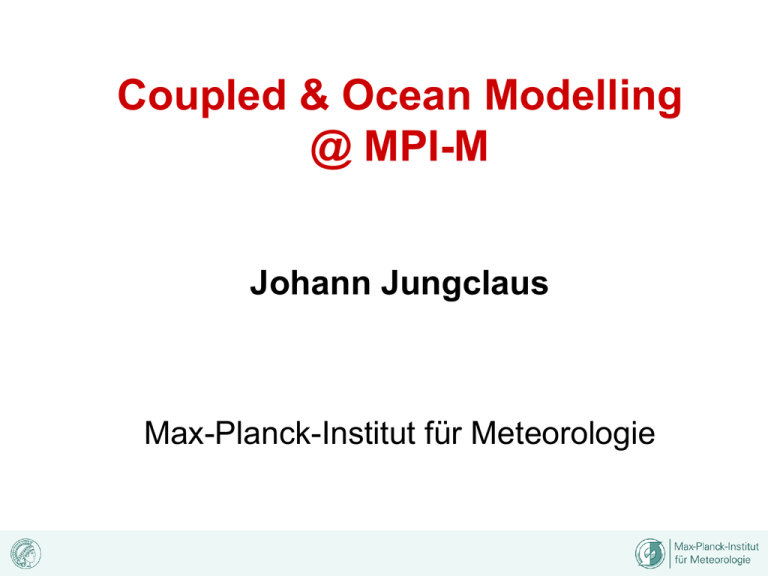
Coupled & Ocean Modelling @ MPI-M Johann Jungclaus Max-Planck-Institut für Meteorologie Ocean model development at MPI-M has presently two foci: Maintain and improve the Max Planck Institute Ocean Model (MPIOM) as part of the MPI-M Earth System Model (E. Maier-Reimer, H.Haak, J. Jungclaus, J-S. v. Storch) Develop a new ocean model in co-operation with new atmosphere model ICON (P. Korn, S. Lorenz, PhD students) The MPI-M Earth System Model Anthropogenic forcing Natural forcing CH4, N2O, CFC conc. Volcanic aerosol CO2 emissions Solar variations Land use change Atmosphere ECHAM5/6 Momentum, Energy, H2O, CO2 Land HD JSBACH Ocean MPIOM HAMOCC The MPI-M Earth System Model • ECHam5/6 (Roeckner et al., 2003), interactive runoff and glacier calving scheme. • Land surface JSBACH (Raddatz et al., 2007), Dynamic Vegetation (Brovkin et al., 2009) • New Radiation • Resolution: T31L19, T63L47, T127/L95, ….. • OASIS 3.0 coupler • MPIOM MPIOM • MPIOM (Marsland et al., 2003), • C-Grid, z-level, partial cells, BBL parameterization • Isopycnal diffusion, GM (Gent et al., 1995; Griffies et al., 1998) • Vertical mixing: PP and mixed layer wind mixing • Hibler-type sea ice model incl. snow and fractional ice cover • Conformal mapping grid: dipole or tripole • Ocean biogeochemistry module HAMOCC5 (Wetzel et al., 2007) MPIOM- grid set-ups dipole grid dipole global application: GR3.0 and GR1.5 dipole regional application tripole grid set-up Tri-polar, quasi-homogeneous 1°, 0.4°, 0.1° Paleo applications PETM (55 Ma) PhD thesis M. Heinemann dipole grid Miocene (15 Ma) PhD thesis M. Krapp tripole grid Resolution matters Griffies et al., 2009 MPIOM: TP04 Resolution matters (sometimes…) Griffies et al., 2009 MPIOM: TP04 Applications • long (and, or many) integrations with effective low-resolution ESM (T31/GR3) • Ensemble simulations of the Last Millennium • Multi-millennia transient experiments (e.g. Holocene) • Sensitivity experiments in paleo environment (e.g., PETM, Miocene) Example: Last Millennium • first ensemble simulations over the last 1200 years using comprehensive ESM including interactive carbon cycle. (In total, almost 20000 years of data!) Northern Hemisphere temperatures: the instrumental period CRUTEM2v Expt. 1 Expt. 2 Expt. 4 HadCRUT2v Expt. 3 Expt. 2 anomalies w.r.t. 1961-1991 mean •Simulation captures warming trend over 19th/20th century •Observed multidecadal variations partly due to internal variability Northern Hemisphere temperatures: the last 1200 years Background shading: overlay of reconstructions (after IPCC, 2007) solid: 5 full forcing expts. (Krivova solar 0.1%) dashed: 3 full forcing expts. (Bard solar 0.25%) • Range of variability consistent with observations, but LIA cooling less pronounced than in reconstruction for 0.1% Simulation of CO2 evolution Solid lines: full forcing ensemble E1 (Krivova solar, 0.1%) dashed lines: full forcing ensemble E2 (Bard solar, 0.25%) Grey shading: Overlap of reconstructions (C. Reick) Applications • Decadal prediction and ocean initialization • No data assimilation for MPIOM available, but benefit from Detlef Stammer‘s GECCO work in the neighborhood • Presently testing several „assimilation“ techniques in AR4 set-up (ECHAM5 T63L31 MPIOM GR1.5L40) : SST (Keenlyside et al., 2008), • GECCO (Pohlmann et al., 2009) • Forced (NCEP) MPIOM runs (Matei et al., in prep.) SAT hind minus 20C COR skill for lead time 1yr NCEP Gain in skill GECCO SAT hind minus 20C COR skill for yr6-10 NCEP Gain in skill GECCO MPIOM at high resolution (0.1°) STORM-project (J.S. v. Storch) - using IPCC AR5 model system (ECHAM6/MPIOM-TP) - long climate change simulations (i.e., 20 century run + 21 century run with RCP4.5 forcing) - horizontal resolution in the ocean: ~ 1/10 degree (10km) - horizontal resolution in the atmosphere: ~ 50 km Scientific foci (among others): - Climate sensitive & dependence of climate sensitive on resolution (e.g. whether and to what extent will climate projections change due to enhanced resolution) - Impact studies (e.g. changes of extreme value statistics…) a snapshot of horizontal velocity speed at 57 m [m/s] ECHAM6/MPIOM in CMIP5 • MPI-M will run CMIP5 experiments 20th century, projections, and decadal forecast using ECHAM6 T127/L95 MPIOM 0.4/L80 „HR“ • Paleo and historic (last millennium) will be run at T63L47 (ECHAM6) and 1°L40 (MPIOM) „LR“ • Expts with interactive chemistry will be run at „LR“ at FZ Jülich (M. Schultz) CMIP5 ECHAM6/MPIOM-HR CO2 CONCENTRATION 2423 control 1850 C 500 1850-2005 C+2*T1 3*156 RCP4.5 2006-2100 C+2*T1 3*95 RCP4.5 2101-2300 T1 RCP8.5 2006-2100 C+2 RCP8.5 2101-2300 T2 RCP2.6 2006-2100 T1+2 RCP2.6 2101-2300 T2 200 3*95 200 3*95 200 C: CORE, T1: Tier1, T2: Tier 2 CMIP5 ECHAM6/MPIOM-HR CO2 Emission 1003 Control C-cycle C 250 1850-2005 C-cycle C 156 RCP8.5 2006-2100 C-c. C 95 1850-2005 decoupled T1 156 RCP8.5 2006-2100 dec. T1 95 1850-2005 rad. only T2 156 RCP8.5 2006-2100 rad. T2 95 C: CORE, T1: Tier1, T2: Tier 2 CMIP5 ECHAM6/MPIOM-HR Initialized decadal 2700 Initialized, 10 yr 30*C+70*T1 100*10 Initialized, 30 yr 6*C+14*T1 20*30 Initialized - volcanoe 15*T1+35 50*10 Initialized + volcanoe 3*T1+7 10*10 C: CORE, T1: Tier1, T2: Tier 2 CMIP5 ECHAM6/MPIOM-LR Paleo: PMIP3 6000 control mid holocene 2000 control LGM 2000 Control Millennium 2000 1400 Mid holocene T1 100 LGM T1 100 Last Millennium T2 1200 Total C: CORE, T1: Tier1, T2: Tier 2 7400 Working fields • Tides (E. Maier-Reimer, M. Müller) • New sea ice model (D. Notz) • Vertical mixing (E. Exarchou, J. v. Storch, JHJ) • Adaptation for high resolution (0.1° or higher) models (non-hydrostatic, nonboussinesq (E. Maier-Reimer)) Tides • Ephemeridic module of Thomas et al. [2001] implemented in MPIOM • Analytical ephemerides for the sun and moon calculated with sufficient accuracy for tidal applications (~0.1‘ for the sun, 1-2‘ for the moon) [van Flandern and Plukkinen, 1998] • Real-time forcing of complete lunisolar tidal potential New sea-ice model The new sea-ice model will include: • A representation of the frazilpancake cycle and the associated brine release • An improved representation of salt fluxes from ice during growth and decay • Multi-layer, multi-category sea-ice thermodynamics • Improved albedo scheme (Pedersen et al., 2009) • Dynamics on triangular grid for ICON is planned ICON: MPI-M's Next Generation Climate Model • Coupled atmosphere & ocean model on identical grid type • Icosahedral grid: unstructured grid that avoids problems of lat/lon grids: pole singularity, non-uniformity of grid cells • Collaboration with German Weather Service (DWD) • Includes data assimilation • Joint pool of physics packages • From short & local to long & global time-space scales weather and climate prediction • Local model refinement: horizontal & vertical • regional/local modelling • covering hydrostatic & nonhydrostatic regime ICON Development Branches 2D shallow water 3D hydrostatic atmos. dynamical core 3D non-hydrostatic numerics + ECHAM physics ICOHAM as successor of ECHAM 3D hydrostatic ocean The ICON Grid Concept of patches for refinement for domain decomposition Unstructured grid minimize distance between neighbors in memory only relationships between neighbors are stored: no traditional array data structure Ocean model versus Atmosphere model Model Hydrostatic Atmosphere Hydrostatic Ocean Vertical coordinate hybrid terrain following z levels Elliptic problem for... a few fast vertical modes, vertical mode decomposition every time step one external mode Equations Commons operators: divergence, vorticity, gradient elliptic solver, time stepping ICON Ocean model Primitive equation model with a free surface Discretization of vector-invariant form of momentum equation Spatial Discretization: C-type staggering Normal velocity: at triangle edges Temperature & salinity: at triangle centers Free surface elevation: at triangle centers Temporal Discretization: semi-implicit two-timelevel scheme ICON Ocean model Dynamics 1st version of dynamical core implemented and tested Physics (work-in-progress) Forcing Momentum/heat/fresh-water fluxes (CORE-project) Bulk formulas Parametrizations Vertical mixing, convection Grid-dependent physics (GM) requires substantial development ICON Ocean model: further development Ocean data assimilation/state estimation using adjoint method Adjoint model via adjoint compiler adjoint compiler as integral part of ICON-Ocean model automatic generation of adjoint code Strategy ICON-Ocean development parallel with adjoint development collaboration with Prof. U. Naumann (RWTH Aachen) Current status adjoint ICON-shallow-water model available



